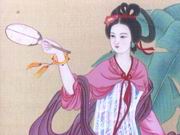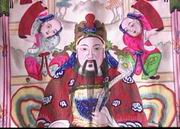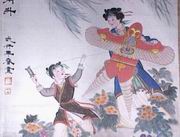 |
|
Multiple New Year Pictures |
| CCTV.COM 2003-08-28 10:08:27 |
|
 The Multiple New Year Pictures of Gaomi City, Shandong Province are distinctive among the various schools of New Year pictures in China. With their unique craftsmanship and style, they are reputed to be one of the “three unique things” of Gaomi City. The Multiple New Year Pictures of Gaomi City, Shandong Province are distinctive among the various schools of New Year pictures in China. With their unique craftsmanship and style, they are reputed to be one of the “three unique things” of Gaomi City.
The Multiple New Year pictures of Gaomi date back to the early period of the Ming Dynasty over 500 years ago. This special form of folk art has matured on the basis of the traditional Chinese painting.
To increase the output of New Year pictures, a folk craftsman drew a rough sketch on a piece of white paper with charcoal. Then he duplicated the sketch on more pieces of paper.
 His whole family finished the pictures in a flow process like a workshop. One applied green colour. Another applied red colour. The master-hand of the family put the final touches to the pictures. His whole family finished the pictures in a flow process like a workshop. One applied green colour. Another applied red colour. The master-hand of the family put the final touches to the pictures.
The Multiple New Year Pictures of Gaomi cover a wide range of motifs such as mountains, rivers, fish, birds, flowers, characters in local operas and historical legends. The pictures can cover everything that implies good luck, jubilation, harmony or happiness.
Most of the pictures are drawn on full-size sheets of paper. So they are commonly known as “large scrolls”, “large horizontal scrolls” or “four-stripe screens”. In the composition of a picture, the painter employs the method of using the few to defeat the many and highlights the lofty images of characters. He even leaves out the background pattern and applies the tactics of traditional Chinese arts like Beijing opera and traditional Chinese painting.
The touches of the Multiple New Year Pictures are bold and unrestrained, simple and refined. The painter works in a natural and graceful way. He lays stress on the portrayal of images and avoids too elaborate painting. The final touch is very interesting. He gets a radish from a jar of pickles and carves flowery patterns on it. Then he dips the carved radish in pigment and imprints it on the painted garment of the character. The flowery dots add appeal to the cotton-padded jacket of the rustic style.
 These tactics of Gaomi Multiple New Year Pictures cannot be found from other schools of New Year pictures in China. These tactics of Gaomi Multiple New Year Pictures cannot be found from other schools of New Year pictures in China.
“Up to now, such multiple pictures have not been found elsewhere in China. We can say such pictures are great freehand brushwork paintings. A rough sketch is drawn first. Then a folk artist wields a painting brush with facility and freedom. There are no strict limits like those in woodcut New Year pictures. So the painter can work at will. To promote the sale of these pictures, the painter uses other means, such as painting in gold lines and applying oil to the picture. The picture looks gorgeous and splendid,” said Lu Hong’en, a folk handicraft expert.
“In the development of New Year pictures, it serves as a link between what goes before and what comes after. The earliest New Year pictures were painted by hand. Then multiple New Year pictures could meet the needs of the market. That was followed by half printing and half painting. Finally it was replaced by block process printing” added Lu Hong’en.
Regrettably this form of art declined at the end of the Qing Dynasty. After the founding of New China, the folk art of Gaomi Multiple New Year Pictures received a new lease of life. They have been well received by people at home and abroad.
|
|
Editor: Han Ling CCTV.com
|
|
|
|
|
|
 |









